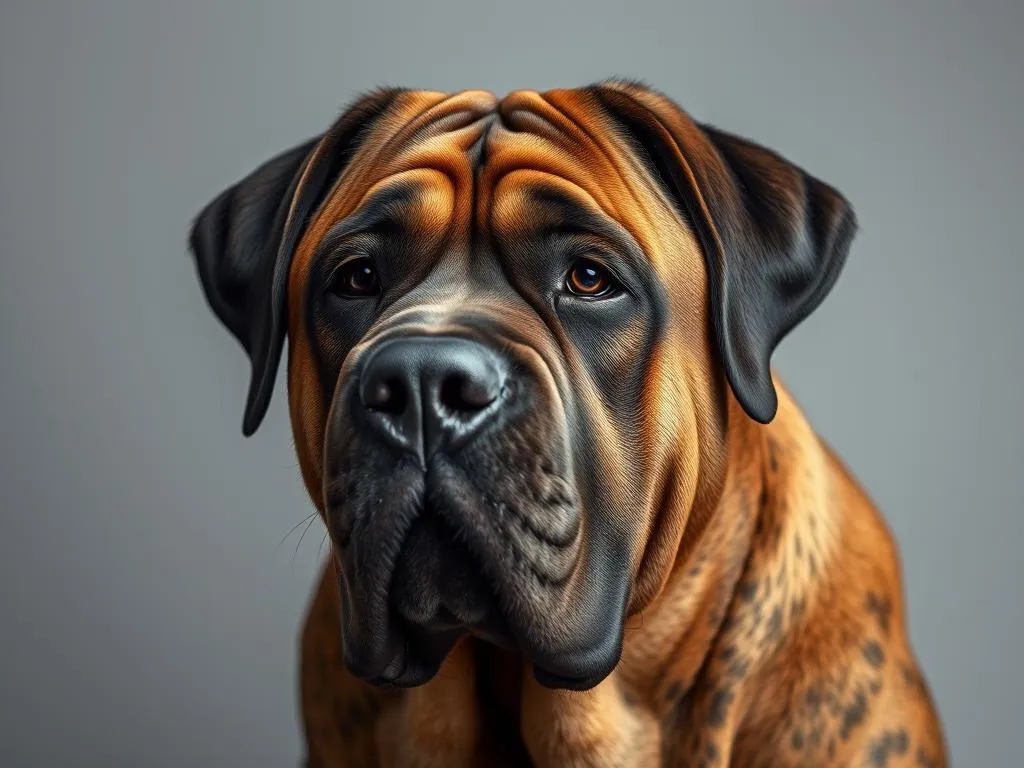
Understanding different dog breeds is essential for potential pet owners, especially when it comes to large breeds like the ultimate mastiff. These gentle giants have a rich history, distinct characteristics, and unique needs that make them a fascinating choice for many families. In this guide, we will delve into the world of Mastiffs, exploring their history, types, care requirements, training, and their role in family life.
Understanding the Mastiff Breed
History of the Mastiff
The Mastiff breed has a storied past that dates back thousands of years. Originating from ancient civilizations, these dogs were primarily used as war dogs, guard dogs, and hunting companions. Their powerful build and protective temperament made them ideal for guarding estates and livestock, earning them a revered role in various cultures.
Over the centuries, Mastiffs have evolved significantly. Initially bred for their strength and size, modern Mastiffs are known for their loyalty and gentle nature. From the Roman Empire to the Middle Ages, these dogs have been recognized for their bravery and companionship, solidifying their position in the hearts of dog lovers worldwide.
Characteristics of the Mastiff
Mastiffs are known for their imposing size and strength. Adult Mastiffs typically weigh between 120 to 230 pounds and can stand up to 30 inches tall at the shoulder. Their coat is short and dense, coming in a variety of colors including fawn, brindle, and apricot.
In terms of temperament, Mastiffs are known for being gentle giants. They are protective yet affectionate, making them excellent family pets. On average, a Mastiff’s lifespan ranges from 6 to 12 years, but they can be prone to certain health issues such as hip dysplasia and heart conditions. Regular vet check-ups and a healthy lifestyle can help mitigate some of these concerns.
Types of Mastiffs
English Mastiff
The English Mastiff is perhaps the most recognizable of the breed. Known for its massive size, this breed can weigh over 200 pounds. English Mastiffs are characterized by their broad heads and muscular bodies. They are generally calm and good-natured, making them suitable for families with children.
However, they can be prone to certain health issues, including obesity and joint problems. Regular exercise and a balanced diet are crucial for maintaining their health. Their protective instincts make them excellent watchdogs, but they are also known for their gentle demeanor.
Bullmastiff
The Bullmastiff is a mix between the Bulldog and the Mastiff, resulting in a stocky and powerful dog. This breed is slightly smaller than the English Mastiff, but they are equally impressive. Bullmastiffs are known for their loyalty and protective nature, making them excellent family pets and guard dogs.
They require moderate exercise and thrive in environments where they can interact with their families. However, their strong protective instincts mean they may need socialization from an early age to ensure they are well-adjusted around strangers.
Neapolitan Mastiff
The Neapolitan Mastiff is easily recognizable due to its distinctive loose skin and deep wrinkles. This breed has a storied history, often associated with ancient Rome. While they are gentle and affectionate, Neapolitan Mastiffs are also known for their strong will and can be challenging to train.
Due to their unique physical traits, they require special grooming attention to prevent skin infections. Their loyalty and protective nature make them devoted companions, but prospective owners should be prepared for the training challenges this breed may present.
Tibetan Mastiff
The Tibetan Mastiff is a majestic breed, known for its impressive mane and thick fur, which helps them thrive in colder climates. Historically, they were used by nomadic cultures to protect livestock from predators. This breed is independent and can be aloof with strangers, making early socialization important.
Tibetan Mastiffs require regular grooming due to their thick coat and can experience health issues related to their size, such as hip dysplasia and eye problems. They are best suited for families with ample space and the ability to provide consistent training and socialization.
Caring for Your Mastiff
Nutrition
A proper diet is crucial for the health and well-being of your ultimate mastiff. Depending on the type of Mastiff, their nutritional needs can vary. Generally, high-quality dog food that is rich in protein and low in fillers is advisable. It’s essential to monitor portion sizes to prevent obesity, as Mastiffs are prone to weight gain.
Common dietary issues include bloat, a serious condition that can affect large breeds. Feeding smaller, more frequent meals and avoiding vigorous exercise immediately after eating can help mitigate this risk.
Exercise Requirements
Mastiffs require regular exercise to maintain a healthy weight and avoid behavioral issues. Daily walks and playtime are essential, but the intensity and duration should be adjusted based on the dog’s age and health. While they are not as high-energy as some breeds, mental stimulation through training and interactive toys is important for their overall well-being.
Grooming and Maintenance
Grooming your Mastiff is essential to keep their coat healthy and maintain hygiene. Regular brushing can help reduce shedding and prevent matting, especially in breeds like the Neapolitan Mastiff. Bathing should be done as needed, but be cautious not to over-bathe, as it can strip their skin of natural oils.
Be attentive to their ears, eyes, and teeth, as these areas can be prone to issues if not cared for properly. Regular check-ups and a good grooming routine can help keep your Mastiff in top shape.
Health Care
Routine veterinary care is critical for all Mastiffs. Regular check-ups can help catch potential health problems early. Vaccinations, flea and tick prevention, and heartworm medication should be part of your Mastiff’s health care plan.
Mastiffs are susceptible to health issues such as heart disease, joint problems, and certain cancers. Investing in pet insurance can be a wise decision for prospective owners to help offset potential medical expenses.
Training Your Mastiff
Basic Training Techniques
Training is vital for Mastiffs, as their size and strength require a well-behaved companion. Early socialization is crucial; exposing your Mastiff to various environments, people, and other animals can help them become well-adjusted adults. Positive reinforcement methods work best with this breed, as they respond well to treats and praise.
Training should start early and continue throughout their lives to keep them engaged. Consistency is key, and using basic commands can help establish a solid foundation for good behavior.
Behavioral Issues
Common behavioral problems in Mastiffs may include stubbornness, jumping, and barking. Addressing these issues early can prevent them from becoming ingrained habits. For instance, redirecting jumping behavior with consistent commands can lead to better manners.
If problems persist, consulting a professional dog trainer familiar with large breeds can be beneficial. They can offer strategies tailored to your Mastiff’s specific needs and behavior patterns.
Mastiffs as Family Pets
Pros and Cons of Owning a Mastiff
Owning a Mastiff comes with its share of advantages and disadvantages. On the plus side, these dogs are incredibly loyal and protective, making them excellent companions for families. Their gentle nature often makes them good with children, and they typically thrive in a family environment.
However, potential owners should also consider the disadvantages. Mastiffs require ample space due to their size, and their health issues can lead to high veterinary bills. Additionally, their training and exercise needs demand a committed owner willing to invest time and effort.
Ideal Living Conditions
Mastiffs are best suited for homes with ample space, as they can be quite large and need room to move comfortably. They adapt well to various living situations, but they thrive in environments where they can spend time with their families. Ideally, a home with a fenced yard is beneficial for their exercise needs.
Integrating a Mastiff into Your Family
When introducing a Mastiff to your family, especially children and other pets, it’s essential to do so gradually. Supervised interactions can help foster positive relationships and reduce anxiety for both your Mastiff and other family members. Establishing routines and boundaries early on can help your Mastiff feel secure in their new environment.
Building a strong bond with your Mastiff involves consistent training, playtime, and affection. Creating a safe, comfortable space for them at home will also contribute to their overall happiness and well-being.
The Mastiff in Popular Culture
Representation in Media
Mastiffs have made appearances in various movies and television shows, showcasing their impressive size and gentle demeanor. From animated films to serious dramas, the portrayal of Mastiffs often highlights their loyalty and protective nature, further enhancing their popularity as family pets.
Mastiffs in Sports and Competitions
In the realm of dog shows and competitions, Mastiffs are often celebrated for their unique characteristics and breed standards. They compete in various categories, showcasing their beauty and temperament. Participation in these events not only highlights the breed’s qualities but also promotes responsible breeding practices.
Conclusion
In summary, understanding the ultimate mastiff requires a deep dive into their history, characteristics, and care needs. These gentle giants can make wonderful family pets when given the proper training, care, and environment. As potential owners consider bringing a Mastiff into their lives, it’s crucial to evaluate their lifestyles and readiness for the commitment involved in caring for such a majestic breed.
Mastiffs are not just dogs; they are loyal companions that thrive on love and attention. With the right preparation and understanding, they can become an integral part of any family.







